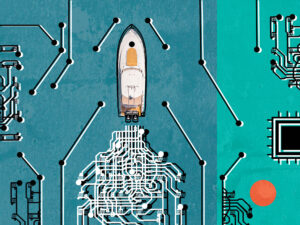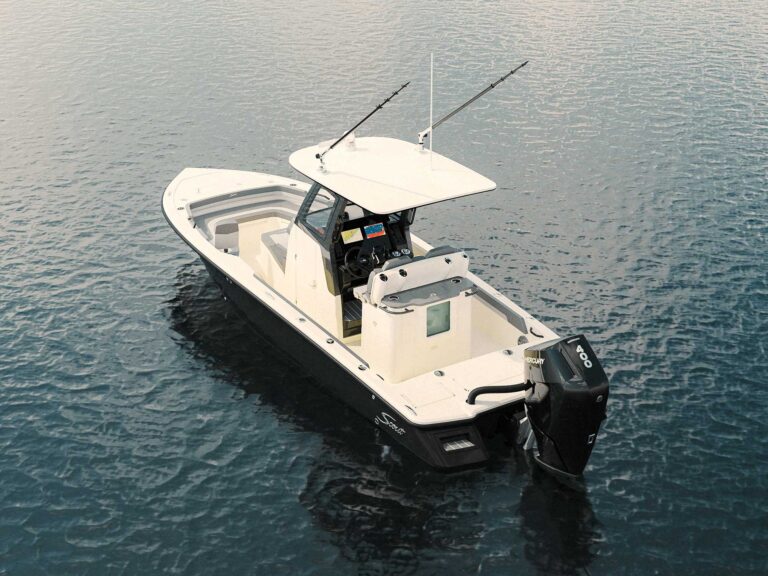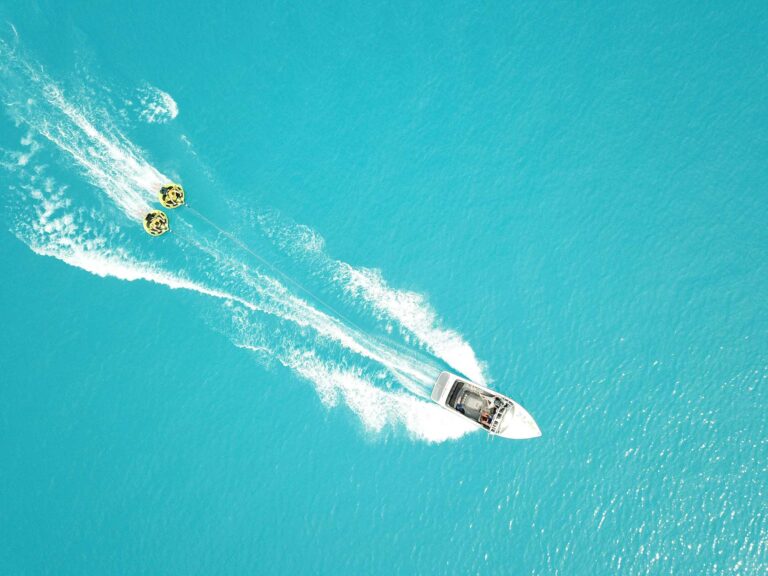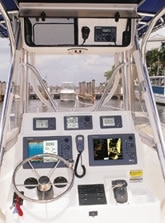
| Furuno’s “Fantasy Helm” is an extreme example of an electronics array on a small center console. |
Marine electronics for midsize boats have come a long way since the days when a well-equipped center console carried little more than a VHF and a depthsounder. Now, almost any boat owner can take advantage of the new navigation, communication and fishfinder technology. Whether you own a 17-foot bay boat or one of today’s super-sized center consoles, there’s a unit to fit nearly any space available while providing performance and functionality that would have been considered wishful thinking just a few years ago. Some of these units may even turn the heads of the big-boat guys, who would prefer an easy-to-use machine that does it all. From compact, stand-alone, multi-function units to multi-screen systems connected by speedy ethernet, the technology is powerful, easy to use and relatively affordable.
Furuno USA

Furuno GP-7000F|
Long recognized for its line of commercial-grade marine electronics, Furuno has been on a diet in recent years, downsizing its technology to benefit the owners of midsize fishing boats. The “Furuno Fantasy Helm” includes twin NavNet color, wide-screen displays, each capable of running chart plotter, sonar and radar functions either individually or in split-screen modes through a high-speed ethernet routing system. They are joined by the FM3000 VHF/DSC radio with Remote Mic; the RF30 Digital Depth and Temperature unit; a CP37 DGPS/WAAS navigator; and a NavPilot autopilot. Furuno shows this system mounted in the center console of a 23-foot Cobia. While it may seem like overkill, the Fantasy Helm clearly shows the kind of system you could put together on a small boat if money is no object.
For 2005, the Furuno introduced its GP-7000/7000F, which greets you with a 7″ wide daylight-viewable, color LCD screen with a 16:9 aspect ratio, sized for running dual functions in a split-screen mode – a big plus when space is tight. The 7000 is a full-function WAAS/GPS plotter that runs the latest C-MAP/NT chart cards. The 7000F combines all these functions with a dual-frequency 600/1000-watt fishfinder. It’s in the 7000F version that the screen size really shines, allowing you to run what amounts to full-screen displays for both functions side by side. The unit interfaces with the company’s autopilot and can be flush-mounted in most consoles or gimbal-mounted on top.
Furuno USA, Camas, WA; (360) 834-9300; www.furuno.com.
Garmin International
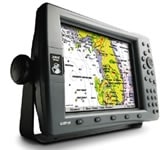
Garmin GPSMAP 3010C|
Networking is definitely on the mind of the folks at Garmin, and I don’t mean the interpersonal kind. The new System 3000 Integrated Marine Network is the hot setup for 2005, and it is available in a single package or as individual components that allow you to expand the system as your needs require. Choices to anchor the system include the GPSMAP 3006C chart plotter with a 10.25″ by 6.5″ screen or the 3010C plotter with a 13.1″ by 8.8″ screen. Both units feature 256-color, daylight-viewable LCD screens, high-speed processors, 12-channel GPS receivers, multi-function displays and Garmin’s proprietary BlueChart navigational charts.
To build on your network you’ll need the GMS 10 network port expander, a powerful microprocessor that operates at speeds rivaling most PCs and has ports to interface with a variety of hardware. If one display isn’t enough, the network will accommodate up to ten screens. You can add a full-function, dual-frequency depthsounder or radar simply by plugging in the appropriate modules. The system can also be linked to XM-WX Satellite Marine Weather by adding the GDL 30 data-link receiver and subscribing to the XM service, which provides a comprehensive array of satellite weather information, including real-time, animated weather data in a chart-overlay form. Garmin offers many stand-alone units that will fit just about any boat size, need or budget.
Garmin International, Olathe, KS; (913) 397-8200; www.garmin.com.
Humminbird

Humminbird 981c SI|
Humminbird’s line takes aim at the salt water market with seven models in the 900 Series, which include the 937c DF and 931c DF that show GPS, chart plotter and sonar functions on a single wide-screen, color LCD. These units provide a feature-packed interface between the plotter, the 12-channel WAAS/GPS and the dual-frequency fishfinders.
Two models in Humminbird’s line, the 947c 3D Combo and Matrix 47 3D Fishing System, offer the company’s “Advanced 3-D Technology,” which takes fishfinding to the next level. The units measure depth at 11 different points inside a 53-degree cone. The system enhances resolution and provides a multi-dimensional representation of bottom and structure detail. The on-screen image is shaded to make it easier to interpret, and the user can freeze and rotate the image for closer examination.
Two more 900 Series units – the 981c SI and 987c SI Combo – offer Humminbird’s Side-Imaging Sonar. Using either a transom-mount or through-hull transducer, the system combines standard down-shooting 2-D or 3-D sonar signals with a side-shooting array that can image structure out to 240 feet on either side of the boat in depths to 75 feet. It provides a totally new look by mapping bottom structure in great detail.
Humminbird, Eufaula, AL; (334) 687-6613; www.humminbird.com.
Interphase Technologies
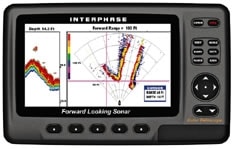
Interphase Technologies Color Twinscope|
While Interphase Technologies produces great, full-function WAAS/GPS chart plotters that are small-boat friendly, the company is best known for its phased-array sonar units. The heart of these units is a multi-element transducer that projects sound waves down, like a fixed-beam depthsounder, or scans the water column vertically or horizontally. The signal returns are displayed graphically in a manner similar to radar, but on a sunlight-viewable, color LCD screen. The transducers have no moving parts and are not much larger than a standard transducer. Scanning sonar offers both navigating and fishfinding advantages while retaining the ability to operate in a fixed-beam, down-looking mode like a standard sounder. And the units are compact enough to fit the helm of any midsize fishing boat.
New for 2005 is the Color Twinscope, which scans a 90-degree path ahead of the boat and can reach out 1,200 feet in both vertical and horizontal modes. The split-screen mode can display side-scanning and down-looking returns simultaneously, so you can see what’s below the boat as well as what’s ahead. It has a 6.1″ by 3.4″ TFT color LCD screen that is easy to read and simple to use.
The new iScan 180 has many of the same features, but uses dual through-hull transducers to enlarge the scanning range to a full 180 degrees and eliminate keel interference on displacement-hull boats. Interphase also offers economical monochrome units and other navigational electronics, and radar is on the way.
Interphase Technologies, Soquel, CA; (831) 477-4944; www.interphase-tech.com.
Lowrance

Lowrance LCX-111C HD|
Lowrance, best known for depthsounder and navigation units designed for small to midsize boats, introduced the LCX line of large-screen combination sounder and chart plotter units aimed at the big-boat market. Now Lowrance is upping the ante with the introduction of a brand-new line of LCX multi-function units designated “HD,” which refers not to “high definition” (as the units already had high-definition screens), but to a built-in, shock-resistant, internal 20GB hard drive with pre-loaded navigational charts and room to add lots more. These units are more powerful than many home computers, with NMEA 2000 networking capability, ethernet expansion ports for radar, and blazing processor speeds. And like all Lowrance products, they are waterproof, so they can be used on small, open boats.
The top-of-the-line LCX-111C HD comes with a super-bright 10.4″ diagonal TFT color LCD screen and a dual-frequency fishfinder that generates 8000/4000 watts of power for incredible readings and depth capability. The chart plotter interfaces with the LGC-2000 12-channel WAAS/GPS receiver. The unit features super-fast screen updates and two digital memory-card slots for recording sounder readings and GPS trip details or transferring data to and from your home computer. A smaller version, the X-26C HD, is a good choice for boats with limited helm space and offers all the capabilities of the 111 with a 7″ screen. These units will be compatible with any of Lowrance’s new open-array or closed-array radar domes, available shortly.
Lowrance Electronics, Tulsa, OK; (800) 324-1356; www.lowrance.com.
Navman

Navman TrackFish 6600|
Navman built its fan base by offering stand-alone depthsounder and chart plotter units that put a lot of electronics on a small helm for a little bit of money. The company sells its compact Fish 4350 and 4380 fishfinders with brilliant TFT color displays for prices in line with many grayscale units. These small units are packed with features, including 200 kHz transducers with 220 watts of power, and proprietary software that maximizes signal returns while balancing noise rejection to provide clear images. Navman’s stand-alone chart plotters are equally impressive in performance and price.
Navman recently joined Northstar, a stand-out in the high-end, big-boat electronics market, as part of the Brunswick New Technologies Group, and the influence is beginning to show. Navman’s TrackFish 6600 is a compact chart plotter and fishfinder that features intuitive controls and a 256-color, WVGA color screen that is stretched vertically rather than horizontally. This arrangement is ideal for gimbal-mounting on a narrow console. In the dual-function, split-screen mode, the unit shows charts on the top of the display and fishfinder readings on the bottom. It runs the latest C-MAP/NT and NT+ cartography, holds up to 3,000 waypoints and even has an optional fuel-flow sensor package that allows it to function as a fuel-management system. The depthsounder function offers dual frequency with 600 watts RMS and depth capabilities exceeding 3,000 feet.
Navman, Acton, MA; (866) 628-6261; www.navman.com.
Raymarine
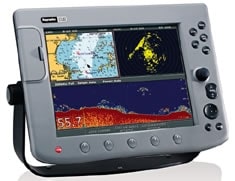
Raymarine C120|
Raymarine, the company that brought the “high-speed bus” fast-data-transfer system to marine electronics, now has a new, even faster way to link electronics data – the C-Series multi-function system. C-Series Navigation Displays run chart plotter, fishfinder and radar functions on a single screen, either one at a time or all at once, and Raymarine offers the screens in three sizes to fit any helm. The C120, C80 and C70 have displays measuring 12.1″, 8.4″ and 6.5″, respectively. All are viewable in direct sunlight and feature prismatic light-enhancing and integrated anti-glare filters for use on open boats. This unit interfaces with Raymarine’s patented HDFI (High Definition Fish Imaging) sonar and any of four available radar domes to complement the chart plotter, which runs the latest Navionics Gold cartography. The system offers multi-screen flexibility and accepts digital depth, speed and temp data, as well as autopilot information.
The HDFI system processes depthsounder signals digitally to eliminate surface clutter and interference and target fish accurately throughout the water column. This new technology is also available in three new, compact A-Series units that will fit on any helm, no matter how small. They include the DS400X, DS500X and DS600X, and are worth a closer look.
Raymarine, Nashua, NH; (603) 881-5200; www.raymarine.com.
SI-TEX

SI-TEX CVS-106L|
The company that invented the color fishfinder has a new, compact LCD version of its popular CRT called the CVS-106L. It features a 5.6″ TFT display with selectable background colors to enhance contrast and brightness under any light conditions. This easy-to-use unit has ten preprogrammed depth ranges and depth-reading capabilities exceeding 1,200 feet, all in a weather- proof case that can be flush- or gimbal-mounted.
The Colormax series GPS charting system is SI-TEX’s latest series of navigation units for midsize boats. The system comes in three different screen configurations to fit a variety of space requirements. The Colormax 6 has a 6″ display, while the Colormax Wide has a 7″ panoramic screen with a 16:9 aspect ratio for enhanced viewing. The big boy of the family, the Colormax 11, has a 10.4″ screen plus two video-input ports to plug in remote video cameras. They all feature SI-TEX’s proprietary Intel XScale architecture for instant screen updates and zoom-in or zoom-out screen changes. The GPS has a WAAS 18-channel receiver and includes a unique feature called the “Guardian Grounding Alarm” that lets you know if your current course will take you close to shoals, obstructions or areas where the water is too shallow to navigate. These units incorporate the latest C-MAP/NT+ cartography and a host of features that make it a standout.
SI-TEX, St. Petersburg, FL, (727) 576-5734; www.si-tex.com.

Click here to buy these products. |


